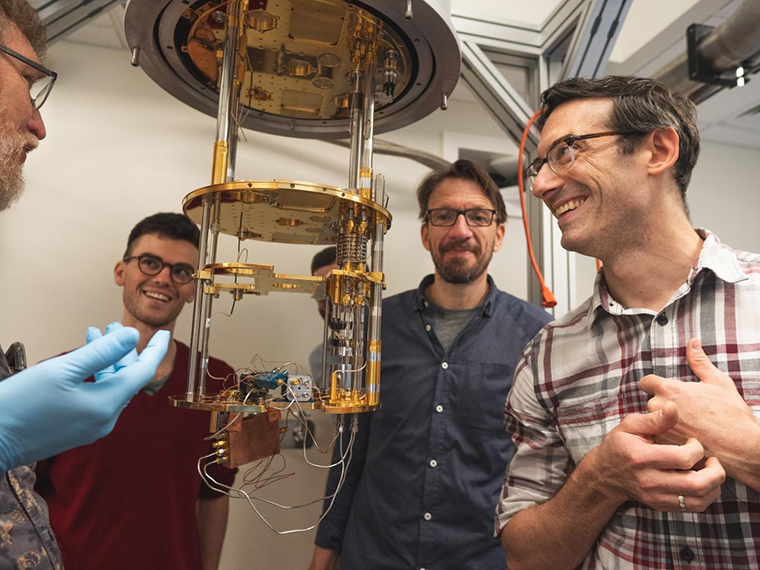Arthur Holly Compton (Sept.10, 1892 - March 15, 1962) was known for many things during his lifetime. Washington University's ninth chancellor, he was a physicist who played the banjo-mandolin at the annual freshman picnic, and he invented the speed bump (yes, really). Before he became chancellor, Compton directed a laboratory that played a key role in the U.S.-led effort to develop the atomic bomb.
But Compton is best-known for a discovery he made 100 years ago, one that paved the way for modern quantum mechanics.
Working in his laboratory in the basement of Eads Hall on the Danforth Campus at WashU, Compton conducted X-ray scattering experiments that demonstrated the particle nature of electromagnetic radiation. It was this discovery for which he was ultimately awarded the 1927 Nobel Prize in Physics.
At the time, the idea that light had both wave and particle properties was not easily accepted. By shining X-rays onto graphite blocks, Compton demonstrated that each ray behaved as a particle, conserving both energy and momentum in collisions with electrons in the graphite. This provided the first proof that X-rays - formerly thought to be a purely wave-like phenomenon - could also behave as particles, confirming a long-standing but largely ignored prediction by Albert Einstein.

"The 'Compton effect' was instrumental in reinvigorating the stalled-out theoretical attempts to understand a bevy of strange experimental results - which resulted directly in quantum mechanics," says Erik Henriksen, associate professor of physics in Arts & Sciences, who helped organize a series of events this year that celebrated the 100-year anniversary of Compton's groundbreaking research.
Members of the Department of Physics created a display in the lobby at Washington University's Olin Library, hosted an Assembly Series lecture by Nobel laureate Frank Wilczek, and offered several Saturday Science Lectures focused on Compton's life and impact.
"Compton had a mix of old school approach - jacket and tie every day - and some sort of American 'can-do' approach to his work," Henriksen says. "He was well-educated, but not stuck in the mud. Most importantly he clearly was willing to alter his preconceptions based on new data.
"And he was empathetic," Henriksen continues. "He wrote about his concern that in coming back here as chancellor, there might be those who would be offended by his wartime work on the Manhattan Project."
From 1942 to 1945, Compton directed the Metallurgical Laboratory of the Manhattan Project at the University of Chicago. His book Atomic Quest not only tells the story of the Manhattan Project and the creation of the atom bomb, but also presents many of his views on the relationship between science and religion, a subject of lifelong concern for him.
Decades later, Compton is most remembered for his impact on the field of quantum mechanics.
"The discovery of the Compton effect is always going to be - or should be presented as - the event that revived the drive toward a theory of quantum mechanics."
Erik Henriksen
"The discovery of the Compton effect is always going to be - or should be presented as - the event that revived the drive toward a theory of quantum mechanics," Henriksen says. "Not that anyone knew at the time where this was going. I'm sure it wasn't obvious at all in 1922 that within 5 years, there would be a solid theoretical foundation for a variety of strange empirical findings."
Henriksen himself is part of the Compton legacy at Washington University. He is a member of the Center for Quantum Leaps, a signature initiative within the strategic plan for Arts & Sciences.
And funders are noticing, too. The National Science Foundation (NSF) is investing $3 million in a new graduate student training program for aspiring scientists and educators who want to explore careers in quantum science at St. Louis-area research laboratories, private companies and other facilities. Henriksen is helping to lead the program, "Linking Quantum Sensing Technologies across Disciplines," or LinQ-STL.
Henriksen recently wrote about Compton in a special remembrance for Physics Today.
"He was a pretty deep guy," Henriksen says, "very talented at building equipment for experiments, and also thoroughly Presbyterian - he has lots of writings about the place of God in scientific research and vice versa.
"Perhaps the most interesting thing was seeing how his thinking evolved as he came to understand his discovery," Henriksen says. "He tried everything to make his experiments fit into the classical perspective. You can really see this in a sequence of publications, before he gave up and accepted the quantum approach."






